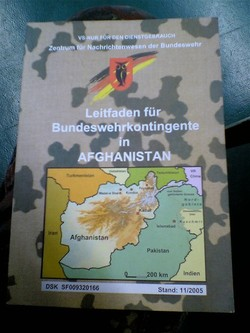Depleted Uranium Ammunition in Afghan War: New Evidence
German Bundeswehr manual challenges US and UK denials over DU in Afghanistan
A classified German Army manual has thrown doubt over US and UK assurances that no depleted uranium munitions have been used in Afghanistan.

21 July 2009 – ICBUW = International Campaign to Ban Uranium Weapons
A military manual that was handed over to German campaigners has reignited allegations that the US used DU ammunition in Afghanistan. If true, it runs counter to repeated assurances given by the US military that no DU was used. The manual, a war-fighting guide for Bundeswehr contigents in Afghanistan is marked classified and for official NATO use only. It was written by the Bundeswehr’s Centre for Communication and published in late 2005.
Campaigners have long suspected that the US military has not been entirely candid over the issue and papers have emerged showing that DU munitions were transported to Afghanistan. The use of A10 Warthog aircraft — one of the main users of DU ammunition — remains widespread to this day, although the number of armoured targets is now much diminished. Estimates by Janes Defence in 2003 suggested that the Taliban had at least 100 main battle tanks and 250 armoured fighting vehicles at the beginning of the conflict. It would be unusual if the US Army had chosen not to engage these targets with DU munitions from the air.
The section on DU munitions begins with:
During the operation “Enduring Freedom” in support of the Northern Alliance against the Taliban-Regime, US-aircraft used, amongst others, armour-piercing incendiary munitions with a DU-core. Because of its pyrophoric character, when this type of munition is used against hard targets (e.g. tanks, cars) the uranium burns. During the combustion, toxic dusts can be deposited, particularly at and around the targets, which can then be re-suspended easily.
It then warns troops how to recognise contaminated targets and of the potential health threat from DU munitions, suggesting precautions that troops should take. It is notable that they suggest the use of full Nuclear Chemical and Biological warfare suits:
DU-munitions can therefore induce toxic and radiological damage to exposed personnel through heavy metal poisoning and very low-level radiation. When it is suspected that these weapons have been used (burnt out cars or tanks, burnt out convoys, typical 30mm bullet holes) NBC (nuclear, biological and chemical) protection suits and NBC masks have to be worn in the vicinity of the munitions’ impact, until NBC security troops can rule out any threat.
Bundeswehr precautionary measures:
– No unnecessary contact with munitions, munitionparts, or any other potentially contaminated material – Examination through NBC troop for possible radiation – Issuing of film dosemeters – Putting on NBC-masks – Sealing up of clothing or wearing personal NBC protection suit – Documenting any contact with DU-contaminated material (who, where, when, what, how long, and dose) – Immediate report with submission of the dosemeter – Calling in of the responsible troop doctor
The contents of the manual raise a variety of questions. Not least of which is that if the Bundeswehr were required to record DU strike sites, is it possible to get access to that information? German campaigners and the German Green Party have submitted a Freedom of Information request asking for any data that the military holds. Also of interest is the decision by the US to deny that DU was used in Afghanistan — a decision that runs counter to their usual position, which justifies the use of DU because it is, apparently, safe.
German campaigners call for government to support DU ban Release of the manual comes at a time of growing political interest in DU in Germany. In particular the Green Party has been agitating for action on the issue, however it has come across resistance from the country’s centre and right-wing parties. The UN’s repeated resolutions on DU encouraged the Greens to propose that the German government implement a domestic ban on DU weapons, urge other countries through the EU, NATO and UN to agree on a moratorium and ultimately work towards a worldwide ban. In a hearing of the Subcommission for Disarmament, the Green proposal was dismissed after the Social Democrats voted against the plans and the Liberals abstained. The Conservative Union, who form part of the ruling coalition, refused to attend. The Subcommission heard evidence from Prof. Dr. Meineke, Head of the Institute for Radiobiology of the Bundeswehr.
German campaigners believe that government movement towards a ban or moratorium on uranium weapons seems unlikely at the moment; a position exemplified by Eduard Lintner of the Conservative Union, who said that DU munitions present no hazard to civilians and only minor threats to troops, which can easily be prevented with appropriate safety measures.
Nevertheless, there are potential signs of support among the Social Democrats and Liberals. The former have said that they are generally in favour of a moratorium, although coalition agreements meant that they dismissed the Green’s proposal. Meanwhile the latter would be interested in further commitment on the DU issue but they abstained from a vote on the proposal because it included a clause about the prohibition of transit and storage of DU in Germany. During the hearing it emerged that the German Department of Defence couldn’t tell committee members how much DU is stored in, or transported through Germany by its allies because it holds no data on shipments.
The German Parliament is now on its summer break and when it returns in September there will be a general election. This means that campaigners will have to wait a little longer for the results of their inquiries into the use of DU in Afghanistan to bear fruit.

